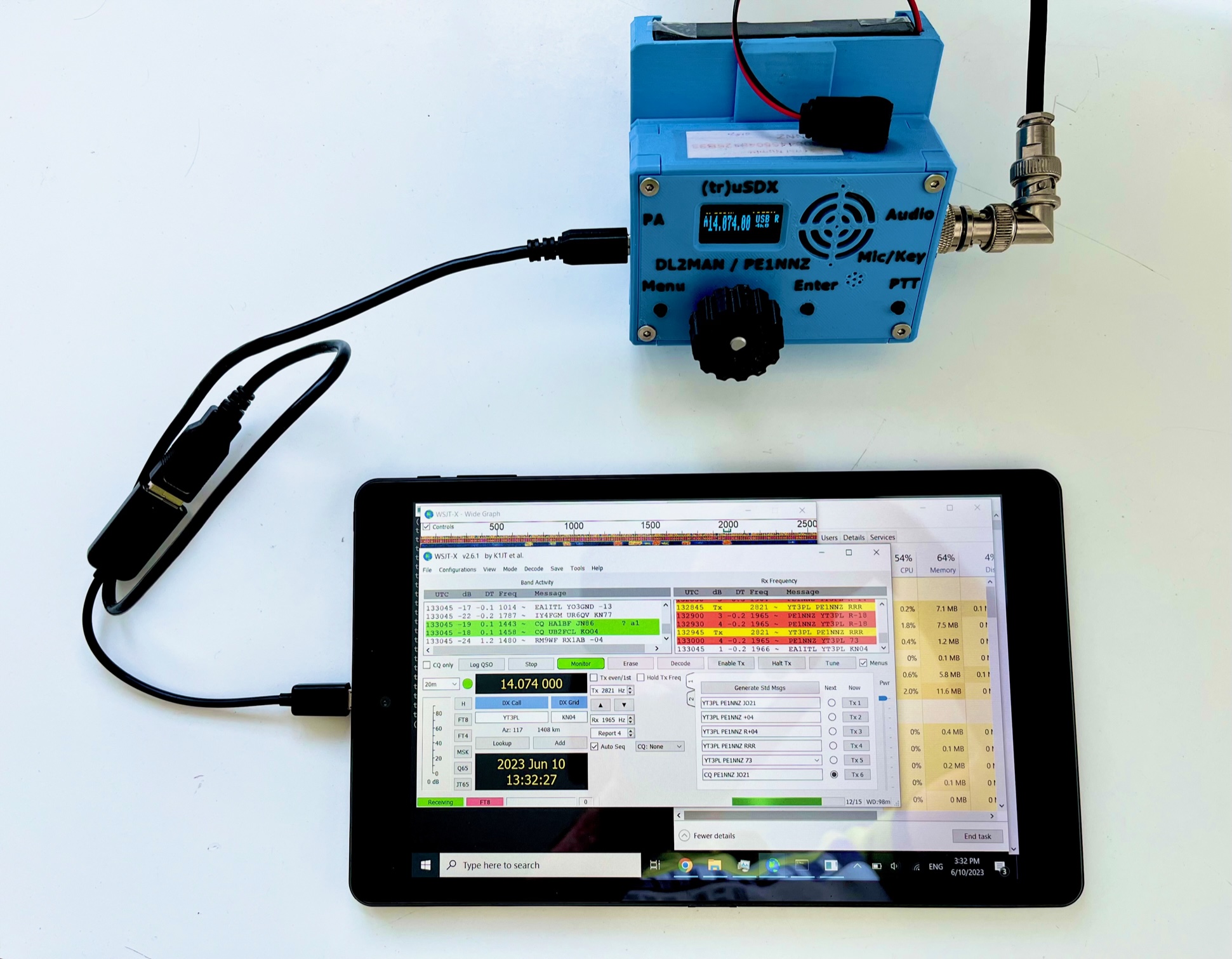This software allow you to send and receive audio to/from your (tr)uSDX (https://dl2man.de/) transceiver via the built-in USB-Serial port.
It enables operating in digital modes using nothing else but a laptop, (tr)uSDX and, obviously, an antenna. Optionally, the external 12V supply can be used for more power. No external audio interface is needed.
The software offers an internal Audio and CAT interface to connect to your digital mode application. For RX/TX switching can be done via: 1. CAT, 2. RTS/DTR (Windows ONLY), or 3. VOX (Linux ONLY with --vox option). Internally, a virtual Audio and Serial Port device is used to bridge the digital modes app to the trusdx-audio app which in turn connects to the (tr)uSDX via CAT streaming protocol.
The software is available for Windows 8, 10 and 11, and Linux. Older Windows versions are supported, but a Virtual Serial port must be installed manually.
It has been successfully tested with:
- WSJT-X
- WSJT-Z
- JS8CALL
- FlDigi PSK31, RTTY
- Winlink (VARA)
- UZ7HO SoundModem Packet Radio
Here is an picture of the setup in action, a (tr)uSDX connected via USB to Windows (tablet) PC, streaming CAT and audio:

Make sure that the (tr)uSDX has firmware level R2.00u, or later.
You'll need a Windows 8/10/11 or Linux PC (Raspberry PI 3 or better should be fine, too).
-
Download the .EXE file from the Releases page. Browser might warn about potential unsafe download, you can ignore this by selecting 'Keep'.
-
Run the setup and follow instructions. Again Windows Protection might give a warning, you can ignore by selecting 'More info' and 'Run anyway'. There might even be a virus warning, in such case disable Windows Protection completely as this is unjustified, the runtime is safe.
-
Connect the (tr)uSDX to the USB port, set volume to 10
-
Run from Start Menu the application:
truSDX Driver
Start a digital modes app (e.g WSJT-X) and select in Radio settings:
- Rig: Kendwood TS-480 (you can also use TS-440 if not available. You can also opt to not use any CAT control if you prefer)
- Poll Interval: 80
- Serial Port: COM8
- Baud Rate: 115200
- PTT Method: either CAT, or DTR/RTS with port COM8
- In Audio tab, select: for Input:
CABLE Output, and for Output:CABLE Input
- Download
trusdx-txrx.py
curl https://raw.githubusercontent.com/threeme3/trusdx-audio/main/trusdx-txrx.py -o trusdx-txrx.py
chmod a+x trusdx-txrx.py
- On Linux, install pre-requisites PulseAudio, PortAudio, e.g:
sudo apt install pulseaudio pavucontrol portaudio19-dev python3 python3-pip
on newest Ubuntu versions you might need to remove pre-installed software that could interfere with serial port, e.g:
sudo apt remove modem-manager brltty
- On MacOS install Python and PortAudio using brew, e.g:
brew install python
brew install portaudio
- Create a new virtual audio device on Linux...:
sudo modprobe snd-aloop
pactl load-module module-null-sink sink_name=TRUSDX sink_properties=device.description="TRUSDX"
-
...or on MacOS:
Go to BlackHole loopback driver page and follow its installation instructions. Remember to install a 2-channels flavour. -
Run the script in terminal:
python3 trusdx-txrx.py -v. -
(Linux) Use
pavucontrolto assign the newly createdTRUSDXaudio device to the application you'd like to use for transmitting and receiving (or do that from the application itself, if it includes audio settings - WSJT-X does).
Start a digital modes app (e.g WSJT-X) and select in Radio settings:
- Rig: Kendwood TS-480 (or 440 if not available)
- Poll Interval: 80
- Serial Port: /dev/pts/x (on Linux) or /dev/ttysxxx (on MacOS, you might have to type it manually). Lookup in terminal which /dev/pts or /dev/ttys port is offered.
- Baud Rate: 115200
- PTT Method: either CAT, or DTR/RTS with port /dev/pts/x or /dev/ttysxxx
- In Audio tab, select:
- on Linux:
TRUSDXinput audio device andTRUSDXoutput audio device - on MacOS:
BlackHole 2chinput audio device andBlackHole 2choutput audio device
- on Linux:
This software is experimental, no warranty or service included.
-
The (tr)uSDX is muted by the driver, however if you like to hear the receiver audio you can add --unmute option (see below)
-
The following options are available (for Windows use truSDX Driver.exe in Program Files directory):
usage: trusdx-txrx.py [-h] [-v] [--vox] [--unmute] [--no-rtsdtr] [-B BLOCK_SIZE]
(tr)uSDX audio driver
optional arguments:
-h, --help show this help message and exit
-v, --verbose increase verbosity (default: False)
--vox VOX audio-triggered PTT (Linux only) (default: False)
--unmute Enable (tr)usdx audio (default: False)
--no-rtsdtr Disable RTS/DTR-triggered PTT (default: False)
-B BLOCK_SIZE, --block-size BLOCK_SIZE
Block size (default: 512)